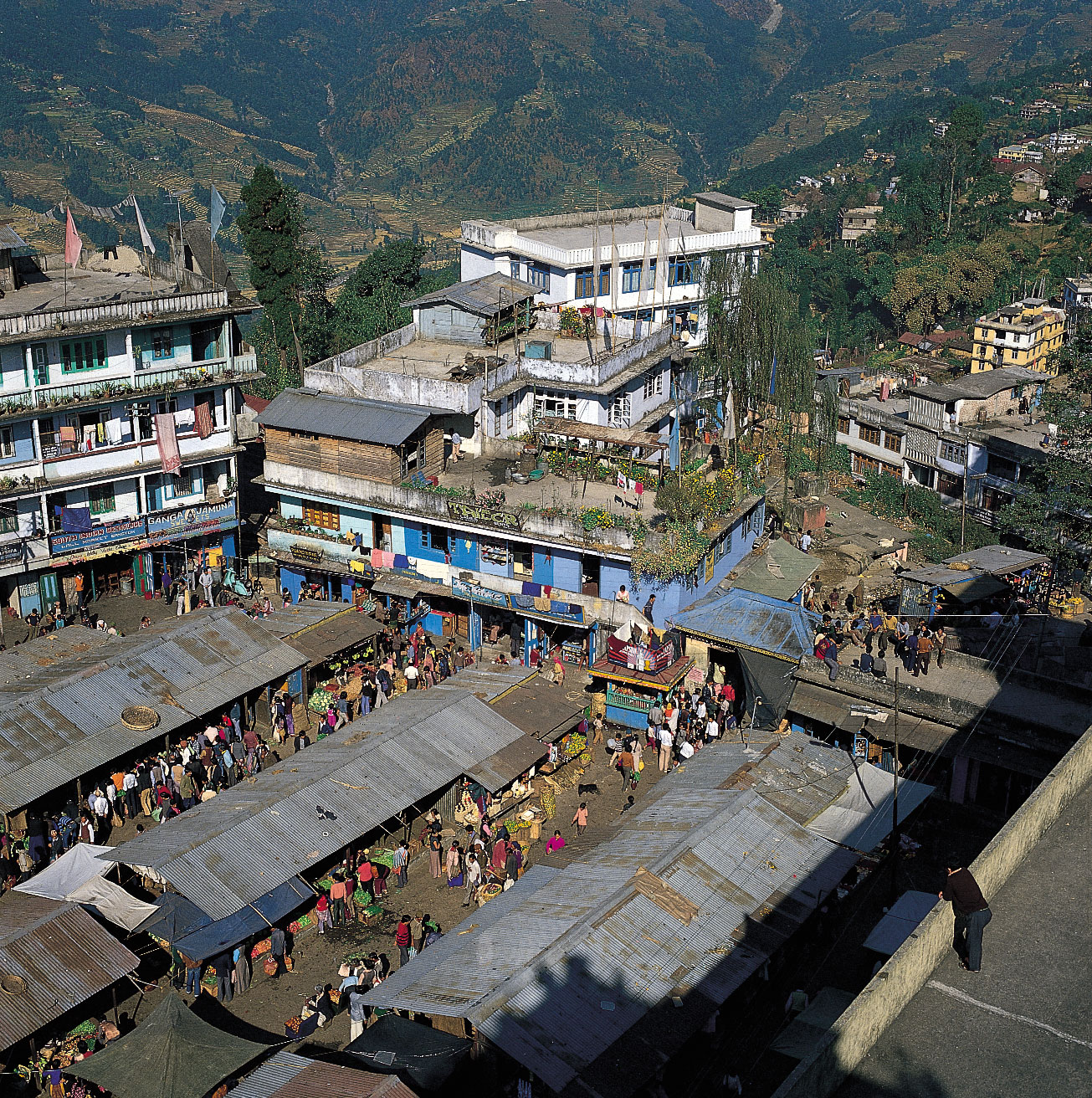Table of Contents
Sikkim, state of India, located in the northeastern part of the country, in the eastern Himalayas. It is one of the smallest states in India. Sikkim is bordered by the Tibet Autonomous Region of China to the north and northeast, by Bhutan to the southeast, by the Indian state of West Bengal to the south, and by Nepal to the west. The capital is Gangtok, in the southeastern part of the state.

Long a sovereign political entity, Sikkim became a protectorate of India in 1950 and an Indian state in 1975. Its small size notwithstanding, Sikkim is of great political and strategic importance for India because of its location along several international boundaries. Area 2,740 square miles (7,096 square km). Pop. (2011) 607,688.
Attempt a Free GK Quiz Now! Download Entri App!
Sikkim Basic Facts
Land
Sikkim is a basin surrounded on three sides by precipitous mountain walls. There is little lowland, and the variation in relief is extreme. Within a stretch of roughly 50 miles (80 km), the land rises from an elevation of about 750 feet (225 metres) in the Tista River valley to nearly 28,200 feet (8,600 metres) at Kanchenjunga, India’s highest peak and the world’s third highest mountain. The Singalila Range separates Sikkim from Nepal in the west, while the Dongkya Range forms the border with the Tibet Autonomous Region of China to the east. Several passes across this range afford easy access to the Chumbi valley in Tibet and, beyond the valley, to the Tibetan capital of Lhasa.
Some two-thirds of Sikkim consists of perpetually snow-covered mountains, dominated by the Kanchenjunga massif. The residents of Sikkim have traditionally viewed the mountain as both a god and the abode of gods. The legendary Abominable Snowman, or yeti, called Nee-gued in Sikkim, is believed to roam its slopes. Other major peaks—all above 23,000 feet (7,000 metres)—include Tent, Kabru, and Pauhunri.
Climate
Sikkim exhibits a variety of climatic types, from almost tropical conditions in the south to severe mountain climates in the north. In Gangtok, temperatures in January (the coldest month) drop into the low 30s F (about 0 °C); in August (the warmest month), temperatures may reach the low 80s F (about 28 °C). Depending on elevation and exposure, annual precipitation varies from 50 to 200 inches (1,270 to 5,080 mm), most occurring during the months of the southwest monsoon (May through October). The heavy rains and snows often trigger destructive landslides and avalanches.
Economy
Agriculture
Sikkim’s economy is based predominantly on agriculture, with the sector engaging more than half of the working population. Corn (maize), rice, buckwheat, wheat, and barley are produced in terraced fields along the valley flanks. Beans, ginger, potatoes, vegetables, fruits, and tea also are grown. Sikkim is one of the world’s principal producers of cardamom. Many of Sikkim’s farmers also raise livestock, including cattle, pigs, sheep, goats, and poultry. Cattle and buffalo are limited mainly to the subtropical humid belt, while yaks and sheep are herded in the higher elevations in the north
The hydroelectric potential of Sikkim’s Tista River system is considerable. There are a few large hydroelectric stations and many smaller plants that provide energy to Gangtok, Rangpo, Singtam, and Mangan. Rural electrification has remained a government priority.
Transportation
Roads, though not extensive, are the primary mode of travel. Ropeways, which are similar to ski lifts, also have been provided at many points. The capital of Gangtok is nearly 75 miles (120 km) from the nearest airport, at Baghdogra, and 70 miles (110 km) from the railhead at Shiliguri, both in West Bengal.
Health
Sikkim has several hospitals and, in each district, at least one community health centre. Rural regions are served by primary health centres and subcentres. The state participates in national programs to control tuberculosis, blindness, and other diseases. Diarrheal diseases (including cholera), respiratory infections of various sorts, hepatitis, and family-planning issues remain among Sikkim’s principal health concerns.
Education
Primary and secondary education in Sikkim is offered free of charge through hundreds of government schools. However, there also are many private schools operating within the state. Higher education is available at a number of institutions, including the Sikkim Manipal University of Health, Medical and Technological Sciences (1995) in Gangtok, as well as smaller colleges offering degrees in law, engineering, teaching, religious studies, and other fields.
For more facts and GK on Sikkim State, Click here!
History of Sikkim
Little is known of Sikkim’s history prior to the 17th century. The state’s name is derived from the Limbu words su him, meaning “new house.” The Lepcha were early inhabitants of the region, apparently assimilating the Naong, Chang, Mon, and other tribes. The Bhutia began entering the area from Tibet in the 14th century. When the kingdom of Sikkim was established in 1642, Phuntsog Namgyal, the first chogyal (temporal and spiritual king), came from the Bhutia community. The Namgyal dynasty ruled Sikkim until 1975.
Sikkim fought a series of territorial wars with both Bhutan and Nepal beginning in the mid-18th century, and Nepal subsequently came to occupy parts of western Sikkim and the submontane Tarai region to the south. It was during this period that the largest migration of Nepalese to Sikkim began. In 1816 these territories were restored to Sikkim by the British in return for its support during the Anglo-Nepalese War (1814–16), but by 1817 Sikkim had become a de facto protectorate of Britain.
In 1950 the Indo-Sikkimese Treaty made Sikkim an Indian protectorate, with India assuming responsibility for the external relations, defense, and strategic communications of Sikkim. The terms of the treaty also included increased popular participation in government, and five general elections based on adult suffrage were held between 1952 and 1974. In the last of these elections, two rival parties merged to form the Sikkim Congress, which swept the polls. The party subsequently launched a campaign to obtain greater political liberties and rights, and the chogyal attempted to suppress the movement. When the situation got out of control, the chogyal asked the government of India to take over the administration. India prepared a constitution for Sikkim that was approved by its national assembly in 1974. In a special referendum held in 1975, more than 97 percent of the electorate voted for the merger of Sikkim with India. Sikkim became the 22nd state of India on May 16, 1975.
Sikkim GK Quiz
Q: Sikkim is the large exporter of
(a) bamboo
(b) chilly
(c) cardamom
(d) None of these
Ans: cardamom
Q: Which is the only Indian State which borders Sikkim?
(a) Assam
(b) Arunachal Pradesh
(c) West Bengal
(d) Bihar
Ans: West Bengal
Q1: Which is the capital of Sikkim?
(a) Singtam
(b) Gangtok
(c) Mangan
(d) Rongphu
Ans: Gangtok
Q2: In which year, the indo-sikkimese Treaty was signed?
(a) 1975
(b) 1950
(c) 1980
(d) 1970
Ans: 1950.
Q2: When was Sikkim established?
(a) 16 May 1975
(b) 16 Feb 1975
(c) 16 June 1975
(d) None of These
Ans: 16 May 1975.
Q3: Sikkim became the 22nd state of the Indian Union in the year?
(a) 1985
(b) 1965
(c) 1975
(d) None of These
Ans: 1975
Q4: Which is the largest district of Sikkim by area wise?
(a) West Sikkim
(b) South Sikkim
(c) North Sikkim
(d) EastSikkim
Ans: North Sikkim.
Q5: The Nathu La pass connects India with
(a) Bhutan
(b) China
(c) Bangala desh
(d) None of these
Ans: China
Q6: Which dynasty ruled Sikkim in 1642-1975?
(a) Dogra
(b) Gaekwad
(c) Namgyal
(d) None of these
Ans: Namgyal
Q7: Which is the Sikkim state Animal ?
(a) Red panda
(b) Camel
(c) Nilgiri tahr
(d) Spotted deer
Ans: Red panda
Q8: Which is the Sikkim state Tree?
(a) Deodar
(b) Sandalwood
(c) Rhododendron
(d) Palmyra palm
Ans: Rhododendron
Q9: Which is the Sikkim state Flower?
(a) Brahma Kamal
(b) Noble orchid
(c) Ranawara
(d) Palash, Butea
Ans: Noble orchid
Q10: Which is the Sikkim state Bird?
(a) Blood pheasant
(b) Great Indian bustard
(c) Paala pitta
(d) Northern goshawk
Ans: Blood pheasant.















